A comfortable and well-designed motorcycle seat is essential for every rider. Whether you’re taking short city rides or embarking on long tours, the right seat can make the difference between an enjoyable and exhausting journey. Over time, however, a motorcycle seat may start to wear out or no longer meet your needs in terms of comfort or aesthetics. In such cases, reupholstering or customizing your motorcycle seat is the ideal solution. So let’s dive into custom seat upholstery.
Reupholstering a motorcycle seat not only extends its lifespan but also significantly enhances its appearance and comfort. Additionally, there are countless customization options available to tailor a seat to your riding style and posture—an essential consideration for long-distance rides. Whether you opt for a DIY approach or hire a professional upholsterer, the possibilities are almost endless.
My Yamaha XT660R seat, for instance, needed reupholstering mainly due to wear and age. This felt like the perfect opportunity to dive into this niche and explore options. Ultimately, I decided to take my seat to Boogaard Company for a fresh reupholstery job.
Why Reupholster Your Motorcycle Seat?
Over time, a motorcycle seat can lose its original shape and comfort due to frequent use. This not only affects the comfort of your ride but can also detract from the overall look of your motorcycle. There are several reasons why reupholstering your motorcycle seat is a smart choice.
Improved Comfort
The primary reason for reupholstering your seat is to enhance comfort. Over time, the foam inside the seat can compress, leaving it hard and uncomfortable. By replacing the upholstery and foam, you can enjoy longer rides without pain or discomfort.
Reupholstering also provides an opportunity to make additional comfort improvements, such as adding extra padding or customizing the seat’s shape to better suit your body.
Enhanced Aesthetics
In addition to comfort, aesthetics play a key role in deciding to reupholster your motorcycle seat. A worn or discolored seat can diminish the overall appearance of your bike. Choosing a new upholstery design in a color and style that complements your motorcycle can give it a refreshed and personalized look. With countless options in colors, patterns, and stitching designs, you can create a truly unique appearance for your motorcycle.


Materials and choices for reupholstering your motorcycle seat
There is more to reupholstering a motorcycle seat than just choosing a new cover. The material of the upholstery plays an important role in both the appearance and comfort of the seat. At least as important is the padding underneath the upholstery. The right combination of upholstery material and padding can make a world of difference in your riding experience. Although I only had the upholstery adjusted, because the seat of the XT660 fits me perfectly, we did look at options for the padding. Boogaard offers several options in this. And in addition to the padding, there is also an option to have seat heating installed, under the right circumstances.
Types of upholstery materials
The outer layer of your motorcycle seat, the upholstery, plays a crucial role not only in its visual appeal but also in its durability and riding comfort.
Leather is a classic choice for motorcycle seats and is often regarded as a premium option. It exudes luxury, feels natural, and perfectly complements the retro or vintage look of many motorcycles. Over time, leather develops a natural patina, adding even more character to its appearance. Additionally, leather is breathable, which is especially important during long rides on hot days.
Vinyl is a popular alternative to leather and has gained significant traction in recent years thanks to improved manufacturing processes. High-quality vinyl is now almost indistinguishable from real leather, while requiring much less maintenance. Vinyl is completely waterproof and easy to clean, making it an excellent choice for riders who frequently face wet conditions. Moreover, vinyl is significantly more affordable than leather, making it an attractive option for riders on a tighter budget.
For those seeking a unique look and feel, suede can be an intriguing choice. Suede offers a soft, luxurious texture and excellent grip, which is particularly beneficial for sporty riding or wet weather. However, suede is more prone to wear and moisture damage. As such, it is often chosen for motorcycles that are less likely to be used in the rain or by riders willing to invest extra effort in maintenance.
In addition to traditional materials, modern options such as textile and mesh are becoming increasingly popular for motorcycle seats. These materials provide enhanced ventilation, making them ideal for riders in warm climates. Mesh is often used in combination with other materials to improve airflow, keeping the seat cool during long rides. While textile may not be as durable as leather or vinyl, it offers greater flexibility in terms of colors and patterns.
Each material has its unique advantages, so the best choice depends on your riding style, climate, and personal preferences.
My new upholstered XT660 seat
Ultimately, for the seat of my XT660, we opted for a reupholstery design using three types of material. The seating area features anti-slip bi-elastic faux leather, which is easy to shape to the contours of the seat and provides flexibility during rides. This anti-slip material improves grip, enhancing stability while riding.
The blue faux leather is from King Countess, made of 100% PVC on one side and 100% polyester on the other. This high-quality, rigorously tested material is universally applicable and available in a wide range of colors, including a shade comparable to Yamaha Blue.
The finishing touches were done with carbon faux leather. Designed for outdoor use, it’s ideal for applications where a carbon-look finish is desired. It complements the side panels of the XT660, creating a seamless transition. Additionally, it’s a durable, rot- and mildew-resistant product with excellent wear-resistant qualities.
One of the best things about new seat upholstery is how it can transform your bike’s appearance. You’ll catch yourself glancing back at your motorcycle every time you step away. While riding, I noticed a subtle improvement in seating comfort, though I couldn’t pinpoint it at first. After all, only the upholstery was replaced.
Now that the weather has cooled and I’ve switched to my textile motorcycle pants, the difference is clearer. The anti-slip surface and extra grip provided by the faux leather noticeably improve ride control. This enhanced grip is a definite upgrade, making it more than just a visual improvement—it’s a functional one too.
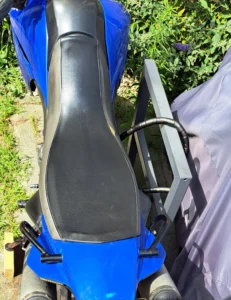
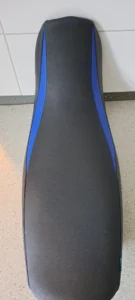
Filling options: more than just the cover
While the choice of upholstery plays a crucial role in the look and first impression of a motorcycle seat, the padding is key to long-term comfort. The right padding provides the cushioning and support you need, especially on longer rides. Common complaints, such as discomfort in the sit bones, can often be resolved by replacing the seat foam in that area. There are several types of padding available, each with unique properties and benefits. Interestingly, gel is more often removed from seats than installed by Boogaard, as it tends to shift during use.
Polyurethane Foam (PU Foam)
PU foam is the most commonly used type of padding in motorcycle seats. It is relatively inexpensive, lightweight, and offers a good balance of comfort and firmness. However, PU foam can sag over time, especially with frequent use, which can reduce support and negatively impact riding comfort.
At Boogaard Company, polypress foam is used in seats for its firm and compact structure. Although firmer, it provides more support than a seat that sags over time. Polypress is a recycled product made from high-density polyurethane foam, consisting of colorful compressed foam flakes with a density of 160 kg/m³. It is even possible to create a lumbar support ridge in the seat, providing extra back support for riders with back pain. The exact location is marked on the seat and customized to the rider’s measurements.
Memory Foam
Memory foam is renowned for its ability to mold to the body’s shape, offering a personalized sense of comfort. This type of foam responds to heat and pressure, providing excellent support. However, memory foam tends to be heavier than other foam types and is less breathable, which may lead to a warm seat during summer rides.
Gel Inserts
Gel inserts or pads are often added to motorcycle seats to provide extra cushioning. The gel distributes pressure more evenly across the seat, helping to reduce painful pressure points. This makes it a great choice for riders who frequently travel long distances. However, gel is heavier than foam and can feel less stable during sportier rides. Additionally, gel may shift from its original placement over time, diminishing its cushioning effect.
Latex Foam
Latex foam is a less common but very comfortable option for motorcycle seats. It has natural breathability, which helps regulate temperature during long rides. Moreover, latex offers an excellent balance between support and softness, without sagging over time.
Choosing the Best Padding for Your Motorcycle Seat
Selecting the best padding and firmness requires careful consideration of your needs and preferences. Take your time when consulting with the person modifying your seat. Think beyond the material or fabric and consider the thickness and shape of the seat as well. Adjusting the seat height, either by lowering or raising it, is also worth exploring.
For custom builds, it is even possible to design and reinforce the seat or foam to perfectly fit a self-made seat base. This level of customization ensures your seat provides maximum comfort and functionality tailored to your specific requirements.
Combinations of filling and upholstery
In many cases, the best choice for your motorcycle seat is a combination of different fillings and coverings. For example, you could opt for a PU foam base with gel inserts for extra comfort on long rides. Alternatively, a seat covered with memory foam and leather offers a luxurious, ergonomic, and durable solution. These combinations can be tailored to your personal preferences and riding style, creating a truly unique riding experience.
To further personalize your seat, consider custom stitching. From a simple overlap seam, commonly used in reupholstery, to the standard seams found on original seat covers, there are several options to enhance the design. Double seams are also possible, adding a stylish touch, as seen on some Harley-Davidson models and aftermarket seats.
Another popular choice is piping. Piping involves adding a trim between two sections of synthetic leather. This feature is often used on choppers and custom builds, as showcased at the BigTwin Bike Expo. Decorative stitching is another way to elevate the seat’s appearance. Options such as Diamond Stitch or Honeycomb patterns can give your seat a sophisticated look, similar to the design seen on the QJ Motor SVR 600 V.
For even more customization, you can add logos to your seat. This could be your personal logo, the motorcycle’s logo, or even your social media handles. The possibilities are nearly endless, and most ideas can be brought to life.
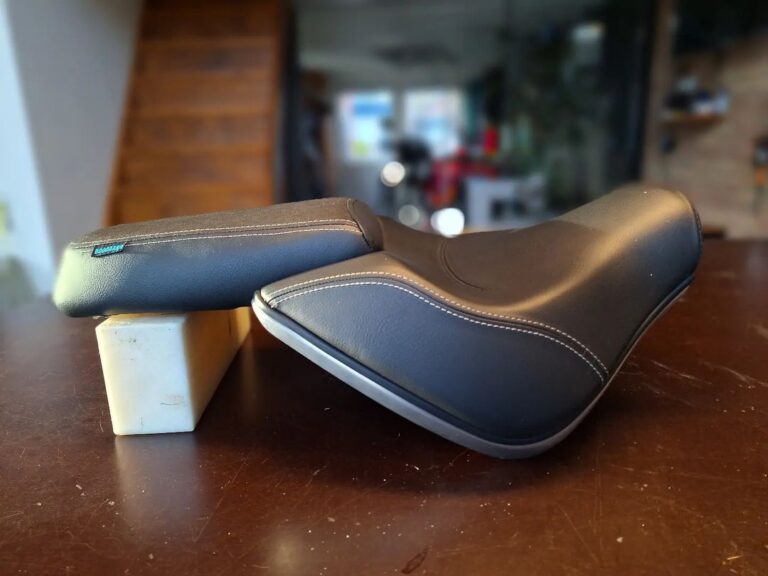
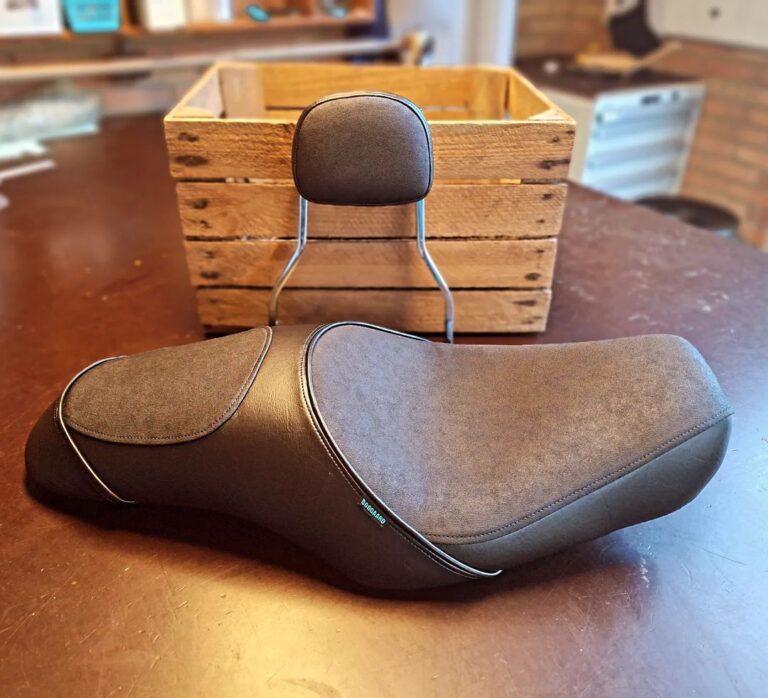
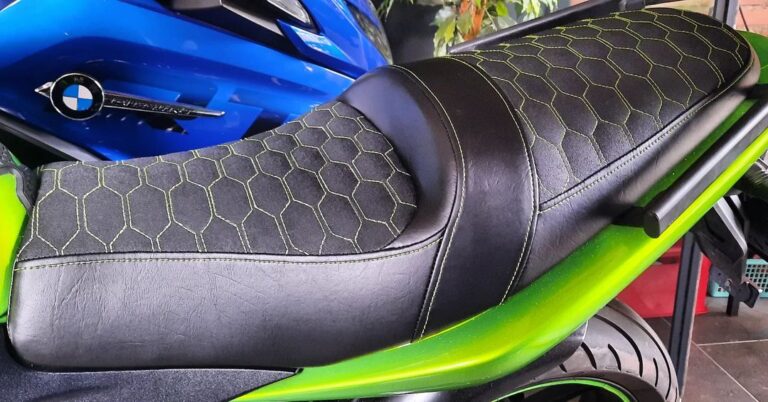
Adjusting the shape and ergonomics of your motorcycle seat
An essential aspect of reupholstering a custom seat is the opportunity to adjust its ergonomics. Every rider’s body is unique, and a seat that doesn’t fit properly can cause significant discomfort, especially on longer rides. Fortunately, there are several ways to customize a seat for optimal riding posture.
The shape of the seat greatly influences your sitting position and overall comfort. Reupholstering your seat gives you the chance to modify its contours. For instance, a seat with a slight dip in the middle can provide better lower back support and prevent sliding forward. Additionally, the seat can be widened for improved weight distribution or narrowed for a more sporty posture.
For riders with specific needs, such as shorter or longer legs, a custom-made seat can make a world of difference. A higher or lower seat can greatly enhance the riding experience by enabling a more secure foot position on the ground. This not only improves safety but also increases riding enjoyment.
Customizing seats for stunt motorcycles offers even more possibilities for stunt riders. For example, adding space for a footrest in the passenger seat is a common modification.
Another popular upgrade is seat heating, which can significantly enhance the riding experience. This is especially beneficial for riders who depend on their motorcycle, scooter, or moped for daily use, as well as those who ride year-round in colder climates.
By tailoring the seat to your specific needs, you can transform your ride into a more comfortable, enjoyable, and safe experience.
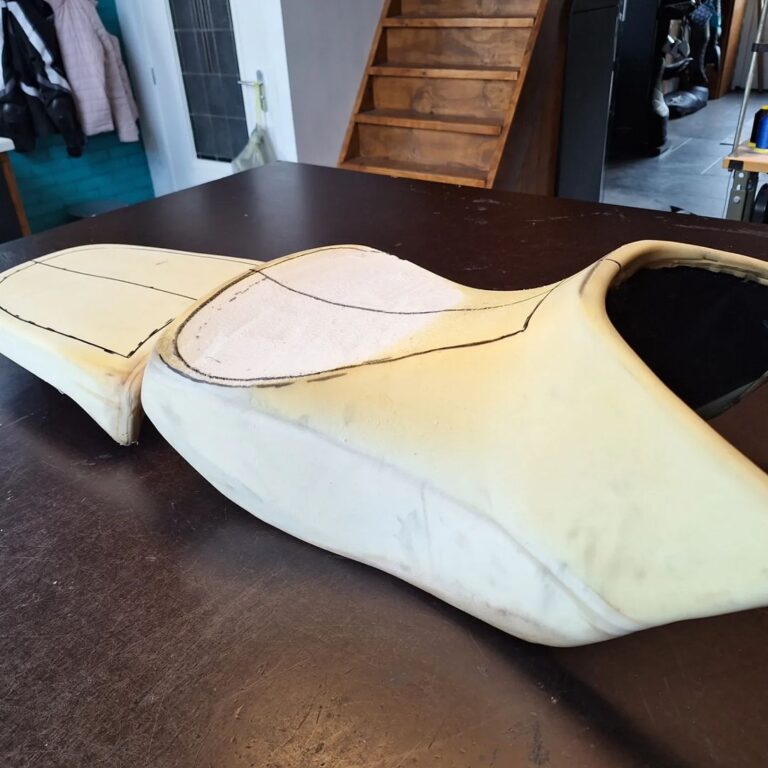
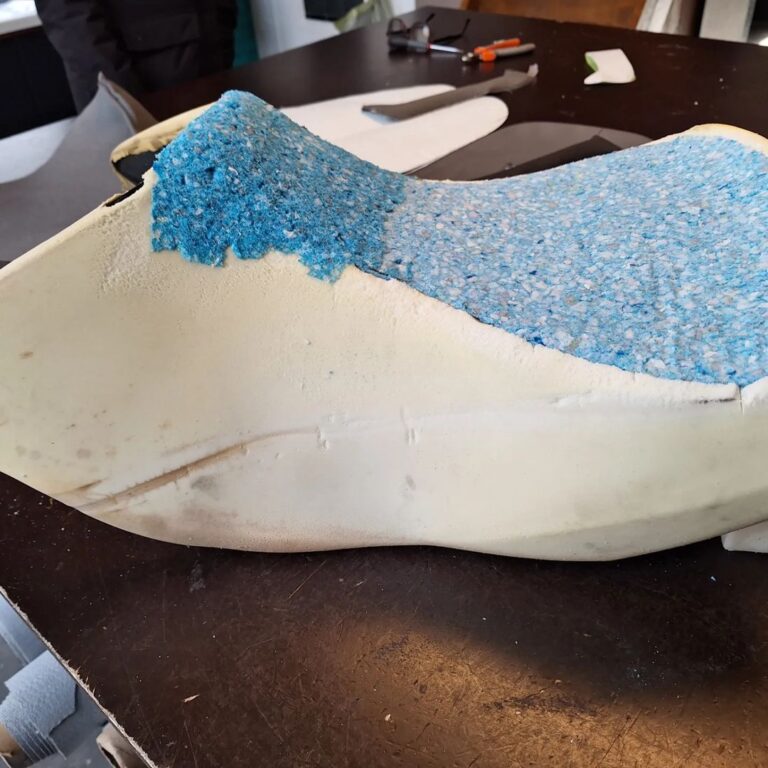
The Pros and Cons of Reupholstering a Motorcycle Seat
As with any modification to your motorcycle, there are advantages and disadvantages to reupholstering a seat. It’s essential to weigh these considerations before making a decision.
Advantages
- Enhanced Comfort: A reupholstered seat with the right materials and ergonomic adjustments can significantly improve comfort, especially during long rides.
- Aesthetic Upgrade: Transform your motorcycle’s appearance with new upholstery that matches your personal style.
- Durability: High-quality materials can extend the lifespan of your seat, making it more resistant to wear and tear and various weather conditions.
- Customization: Tailor your seat to meet your specific needs and preferences, creating a more personalized and enjoyable riding experience.
Disadvantages
- Cost: Reupholstering and customizing a motorcycle seat can be expensive, particularly if you opt for premium materials or hire a professional.
- Time Investment: Customizing your seat may take some time, especially if it’s made to order. This could mean being without your motorcycle for a while.
- Maintenance: Certain materials, such as leather or suede, require regular care to maintain their condition and appearance.
- Not Always DIY-Friendly: While DIY options are available, reupholstering a seat can be a complex process requiring skill and craftsmanship to achieve professional-looking results.
My experience and benefits
I primarily experienced the benefits of this upgrade. My seat was damaged and needed repairs, making the cost and time investment partially unavoidable. In consultation with Boogaard, and considering the year-round use of the XT660, we explored options that required minimal maintenance to stay in good condition.
By incorporating color and following the original lines, the custom seat appears as though it’s factory-original. However, it’s a unique piece that perfectly complements the rest of my bike. The added extra grip was a pleasant surprise, and it’s something I’ll especially appreciate during the winter months.
Personally, I chose not to replace the foam in the seat. It was in good condition, and I can comfortably ride on it for full days. A long weekend in the Eifel posed no issues. That said, there are many customization options available these days, including various fillings. Heated seats, in particular, sounded very tempting.
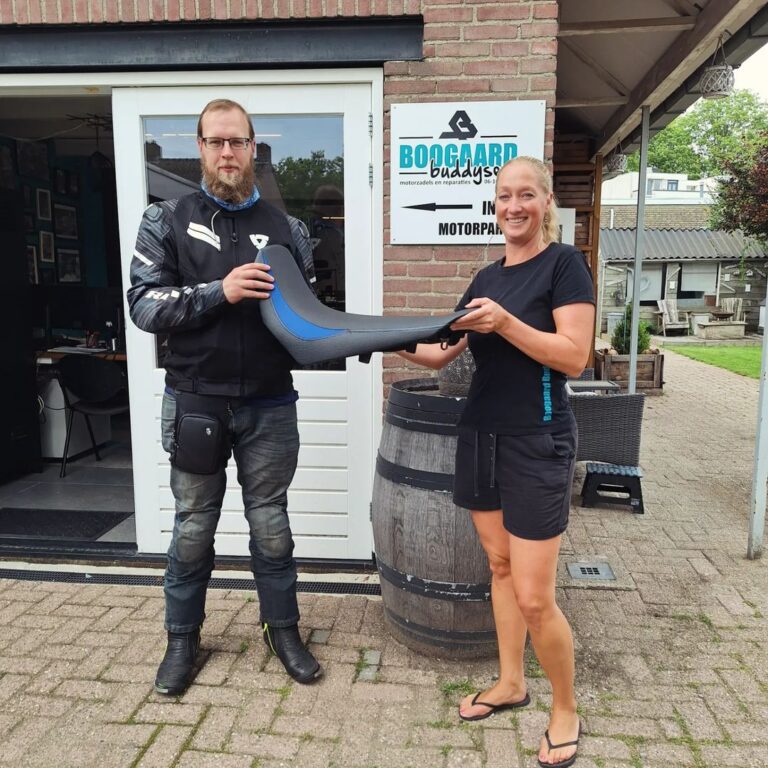

Conclusion
A few weeks have passed, and I can’t help but wish I had done this sooner. The XT660 now looks neat and refined, and it feels more like my own motorcycle again. It’s combination of different faux leather materials creates a cohesive design, where Vera van Boogaard’s expert advice was invaluable. My new custom seat now looks factory-made, perfectly matching the colors and contours of the bike.
The flexibility and personal touch of a small family business were a huge advantage for me. All the communication regarding my preferences and requirements resulted in this fantastic outcome.
Today, there are countless options available for custom seats, with each upholsterer offering their own unique packages. This is why clear communication beforehand to discuss your preferences and possibilities is essential. In the end, a new seat can completely transform the feel of your motorcycle, making it a worthwhile upgrade.
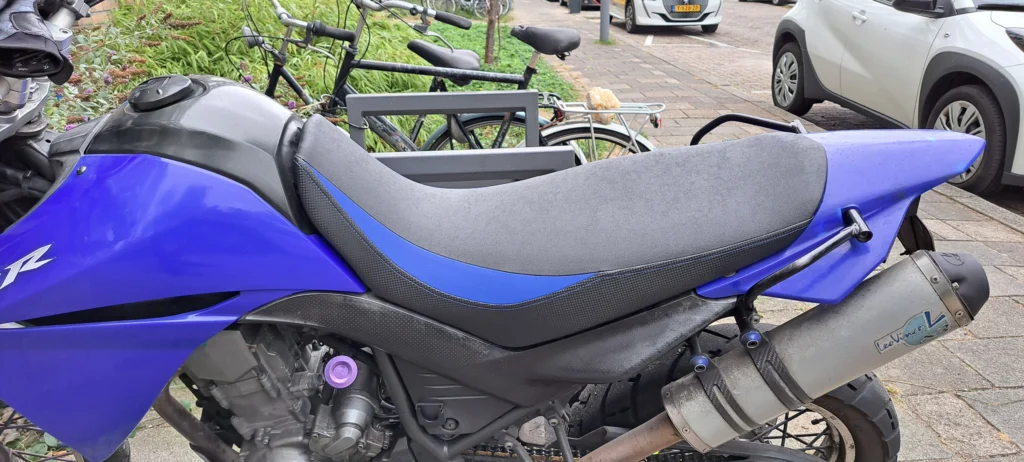
Meer Posts
Ride-On – Sealant en Balanceer (2023)